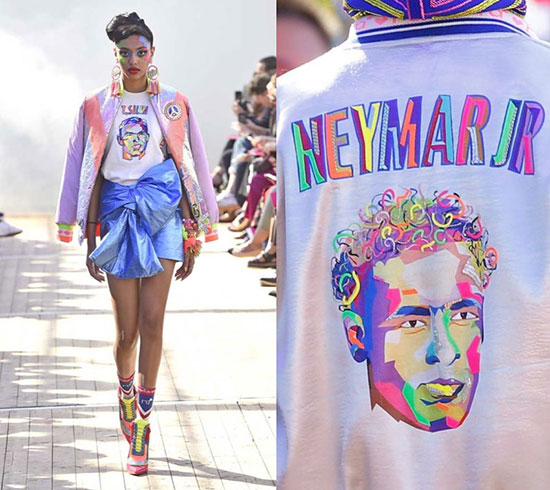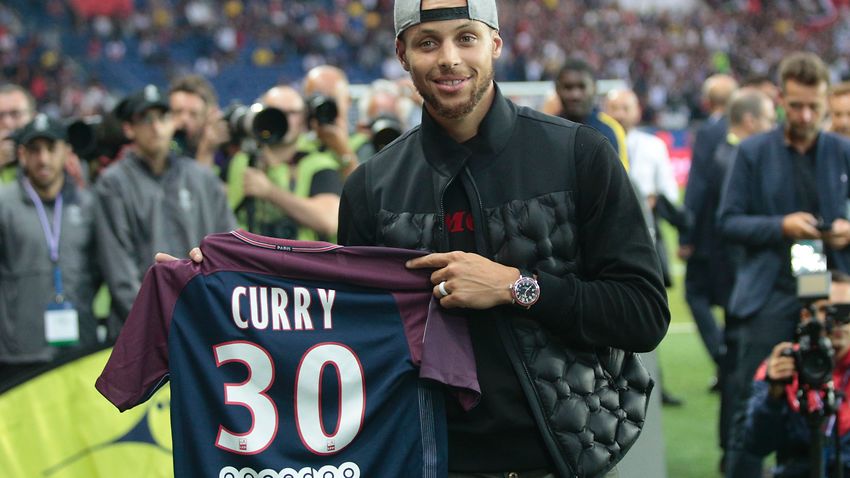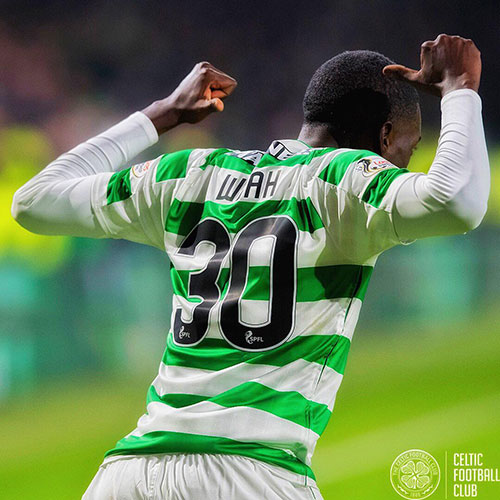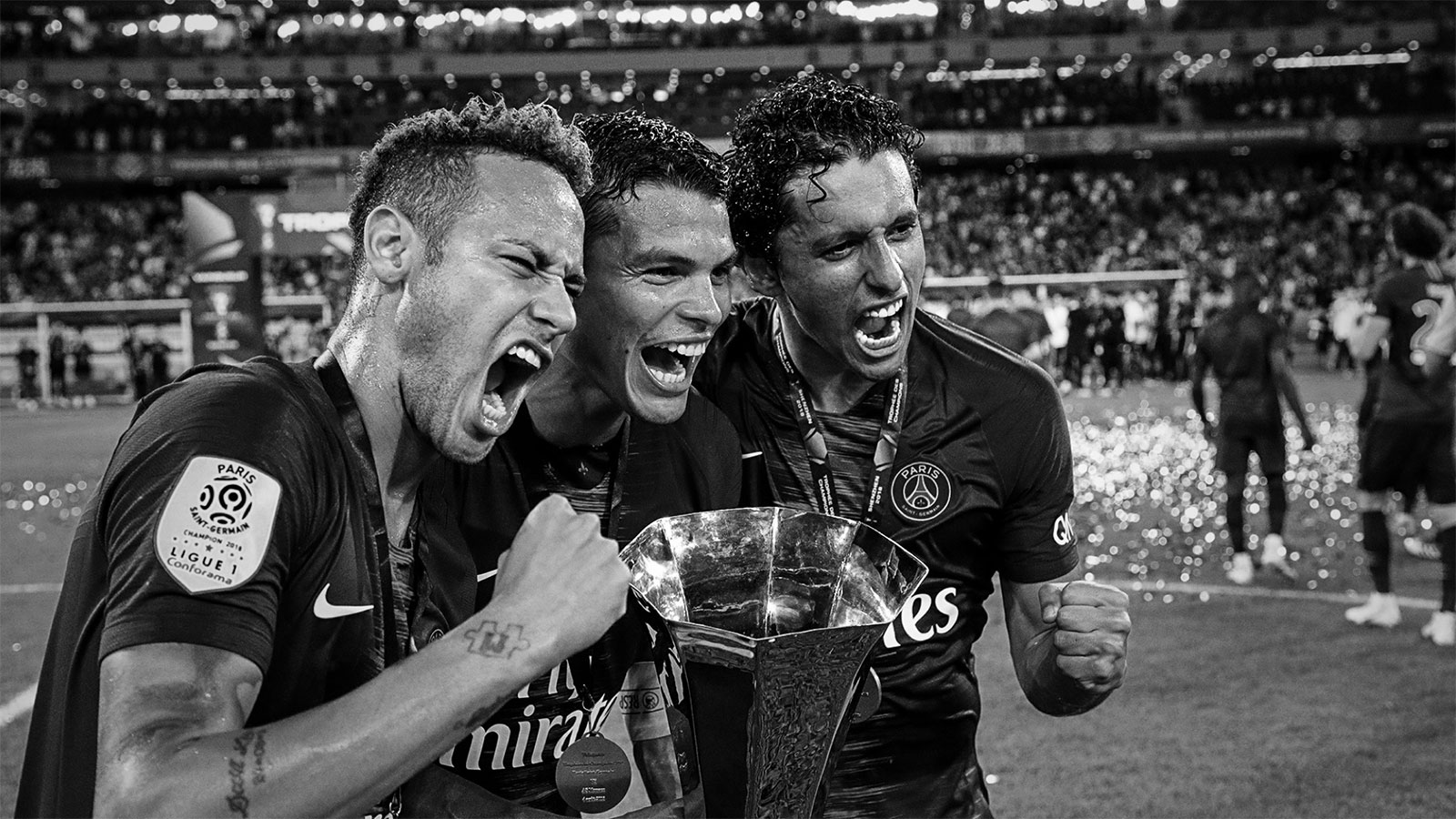Inside PSG's Grand Plan to Become the World's Coolest Sports Brand
Our chat with the French soccer club's U.S. chief
For a team that’s never won the UEFA Champions League, that holy grail of European club soccer—having reached the semifinals just once, back in 1995—Paris Saint-Germain’s goals for the future are very lofty indeed.
And why not?
PSG’s Qatari owners have spent well over $1 billion on players since buying the team in 2011, snapping up such huge names as David Beckham, Zlatan Ibrahimovic, Kylian Mbappé and Neymar. And while Champions League success remains elusive—PSG painfully crashed out in the Round of 16 this year, victim of a controversial late penalty against Manchester United—the club perennially dominates the French league and will surely be victorious in Europe before long.
But that’s just part of the story.
As PSG pursues greater success on the field, it’s also aggressively constructing a sweeping global brand off the field—crafting an image that’s cool, premium and ultra-fashionable, and could extend well beyond soccer, even beyond sport.
Celebrities have been flocking to the PSG brand lately—Justin Timberlake, Beyoncé, Will Smith, Travis Scott, Spike Lee and Stephen Curry have all been spotted in the club’s gear. And a 2018 deal with Jordan Brand to create PSG’s Champions League uniforms, as well as a full range of Jordan-branded PSG wear, has caused the company’s shirt sales to skyrocket.
Some soccer purists bemoan the team’s meteoric, cash-fueled rise to the top, irked by what they see as a strategy of simply buying trophies and prestige. But PSG isn’t fazed by all that—after all, being beloved by many is certainly worth being loathed by a few.
Developing a strong presence in the U.S. is a key part of the club’s global growth strategy—American culture being a key driver of the world’s biggest lifestyle brands. To bolster its U.S. presence, PSG opened an office in New York City last May, its third global outpost outside of the Paris headquarters after Qatar and Singapore.
The NYC office is led by Jérôme de Chaunac, managing director of the Americas. Muse spoke with de Chaunac about PSG’s global vision, the DNA of its brand, and its multilayered marketing strategy that aims to win over Americans—whether they love soccer or not.
Our interview has been edited for length.
Muse: What are PSG’s global ambitions, at the core?
Jérôme de Chaunac: The global objective is to become one of the top sports brands in the world. What is interesting in that sentence is we’re not talking about football or soccer. We’re talking sports. And we’re talking about a brand, not just a team or a club.
To do that, we basically have to do two things. The No. 1 thing is we have to win. At the end of the day, we are still a soccer team. And then, the other thing is, we need to inspire and entertain to build the brand.
On the winning side, the club has invested in, first of all, players. We brought on very talented players, but also some names, because we need to start having people looking at us not only as a good team but as a very ambitious team. If we are able to bring on board the best players on the planet, then we’ll hopefully be able to win the biggest titles. The results have been phenomenal at the French level. Obviously, the holy grail is winning at the international level and in the Champions League. We’re a young team, so it’s a work in progress.
We’ve also invested in coaches. We’ve revamped our stadium. We’re investing 300 million euros in a new training facility in the suburbs of Paris, with the most modern technology for health and training, so our players can be in the best environment possible to reach that goal of winning.
We’re also investing in women’s football—our team is one of the best in Europe—as well as in youth sports and academies, and in esports. We were the first big team in Europe to have an official FIFA esports team—playing in PSG jerseys, participating in global competitions. We believe that being a strong brand in the environment of esports, we can attract more and more people to our brand.
And how about the brand side? What is the DNA of the PSG brand?
Our No. 1 asset is the city of Paris. We’re lucky to have Paris at the core of our brand. We’re lucky to have the Eiffel Tower at the core of our logo. Paris means so many things to so many people around the world—from history to culture, to more modern values like design, fashion, gastronomy. The City of Lights. The City of Love. It’s such great material that we can build around, and we are truly leveraging that asset as part of who we are.
The other thing is, we are the only team in Paris. When you look at all the other major cities in Europe, there are at least two, sometimes three—in London, seven or eight—teams that compete in the same city. We are the only one in Paris. So, PSG equals Paris, and Paris equals PSG. That gives us a stronger position.
The other thing that is unique is, among the top European teams, we’re the youngest by far. We’re only going to turn 50 years old next year—2020 will be our big anniversary celebration. All the other big teams were born in the early 20th century or late 19th century—which obviously gives them a lot of tradition and history, but it gives us the ability to be much more nimble and agile as a brand, and also be perceived as cool because we’re young. And we can be more innovative.
So if you bring all this together, we truly are the coolest brand in the world of soccer, we are a lifestyle brand, a premium brand. And that positioning has been expressed through a lot of different collaborations and partnerships and developments in the world of entertainment.
Tell us about that. You’ve certainly had a lot of interest from the fashion world.
We’ve worked with two fashion designers recently—a French fashion designer called [Christelle] Koché and an Indian designer called Manish Arora. We’ve given them the brand, and they’ve played with their own artistic values and creativity to create fashion lines. We were on the catwalk in Paris and in New York for Fashion Week with those collections. It really brings a point of differentiation to PSG. We’ve also worked with many brands, not just typical partnerships or sponsorships. We do have that, of course, but the likes of Levi’s, for instance—we’ve created capsule collections together.
We’ve also gone to the world of music. We did a big collaboration with the Rolling Stones. The world of art also is something that we work a lot in. We’ve partnered with artists to give them the ability to create within our brand—whether it’s to create a limited edition of one of our jerseys, or posters for our games, or new products like skateboards, this kind of stuff.
All these products allow us to have a different retail strategy, which is not just to be there in the Nike stores and the PSG stores, but we’re also present in some really high-end retail stores that are very different from traditional soccer-team stores. That’s a way to position ourselves pretty differently.
So the goal is to make the brand cool and exclusive, but also broadly appealing?
Definitely cool and exclusive. Lifestyle is a word we use a lot—it transcends sport, really. If you’re a fan or a partner or the media, the story we tell is quite different, and honestly more interesting and appealing. It allows us to get new people interested in the brand, people who would not necessarily watch a football game or follow Neymar or know who Kylian Mbappé is.
Like the new hoodie that we’ve made with BAPE, for instance, which is a high-end fashion Japanese brand that we partnered with. BAPE has small community of fans. And when we bring those two communities together, it creates some unique opportunities to bring new people into the brand.
The Jordan Brand partnership was huge for PSG.
It was just amazing. And to be honest, it wasn’t just amazing for PSG, it was also amazing for Jordan. We’re less than a year into the partnership, so it’s a little early to have big conclusions about the success of it, but all the different criteria we had in mind and could measure—so far it’s been a huge success.
As you know, Jordan is part of the Nike family. Nike has been our partner for almost 30 years now. It’s a very strong relationship. We have become one of Nike’s biggest assets in the world of football, which we were not 10 or 20 years ago. But now we are surely one of the top three clubs that Nike have in the world. We were looking at different opportunities to continue to innovate within that relationship, and we started talking about the Jordan Brand, which so far had not gone into the world of soccer, which is the No. 1 sport in the world.
Both brands have a very similar approach to their business and their brand. On the one side, it’s all about performance. Michael Jordan was, of course, one of the greatest athletes of all time, and everything he represents from a sporting point of view is excellence and performance. Obviously, we also are aiming at becoming the best team in the world. So having the opportunity for our players to play with a Jordan logo on their chest, to be associated with the success of Jordan the athlete and Jordan the brand, was a tremendous opportunity.
The Jordan/Nike-designed jerseys were incredibly well-received by the public. Very high-end and trendy. Black and white. That was the No. 1 pillar of that collaboration, based on what is at the core of each brand.
But also, the two brands are about style. The Jordan brand has become a true global lifestyle brand over the past few years. And we are starting to be recognized as one of the trendy sports brands—definitely the soccer brand that is premium and exclusive and built around a lot of fashion and lifestyle values. Therefore, it was the perfect match.
You also created much more than just soccer jerseys.
We wanted to provide hoodies, sneakers, jackets, things that are not necessarily inspired by what happens on the field, but much more by fashion. The way we’ve done that is by creating collections with a small number of units. So we create, in a way, some scarcity. People are rushing to them whenever we release new products. And we sold out all our collections.
And we created an incredible logo. The Jordan jumpman looks quite similar to the Eiffel Tower. From a design point of view, it was very, very well done.
Sales of the product on the first days of the release were just incredible, and included a lot of North American fans, which was kind of a first for us. We’ve always had a lot of fans here. But the Jordan Brand really helped us go beyond in terms of getting recognized in North America as truly a new brand that is attractive in the world of sports—not just because we win on the field but because we’re a cool lifestyle brand behind that.
For the first time in our history, we’ve hit 1 million in jersey sales around the world. That’s for all our jerseys—the Nike one that we play with in the French league, and the Jordan one that we played with in the Champions League. We were around 800,000 last year. It’s going to be more than 1 million this year. Only two or three clubs in the world do that.
You have a three-year exclusive partnership with Jordan, right?
Yes. So the next two years will bring other opportunities to leverage the partnership—the performance side and the style side, where we will create beautiful new jerseys and new collections of products.
We launched the jersey back in September in New York with a three-day pop-up that we had in SoHo. Obviously, we had some soccer fans coming by. And it was all about the PSG history and those two brands getting together. But we also had a lot of people who are not necessarily even aware of what the PSG brand is. They got connected to the brand and suddenly became fans. So it’s really a way for us to penetrate the market in a greater way.
I saw Justin Timberlake and Beyoncé in PSG gear. Do you pay them as influencers?
We don’t pay them. But it is part of our strategy to become the brand of reference in the world of football, and even in the world of sports, among influencers and celebrities. We need to make sure that Paris and our stadium, Le Parc des Princes, is a place where those people want to be. We’ve created opportunities for celebrities to attend our games, to visit our stadium, to meet with our players, to create those bonds. Whether it’s because they’re attracted by Paris, or they like soccer, or they see the PSG brand as the new fashionable, trendy thing, they all want to be there.
We’re happy to provide them with some of our jerseys and products. For Beyoncé, we offered her a unique piece—a jersey with Swarovski diamonds on it. It was a unique piece. But she decided to post a picture of herself in it—we didn’t pay her at all.
It’s also important for us to engage with those celebrities when they get back home. It’s not just about them being in Paris. That’s why we now have offices in Asia and the Americas, so we can be closer to those potential celebrity influencers—to make sure they take the PSG brand back to their local fans. When LeBron James recently came to the Staples Center for a game wearing a PSG jersey, he got it when he met with Neymar and Mbappé in Paris weeks before that. We never asked him to put it on. If we asked him, he wouldn’t do it. But it is a nice jersey, and that’s why design is very important for us. It’s just the way it works. It has to be authentic. Otherwise it’s not going to work.
How are you engaging in the U.S., from hard-core fans down to regular consumers?
It started with our summer tours [of the U.S.] over the past few years, and on the merchandising side working with Nike. And we have our academies. But last year, we decided we needed to have a permanent presence here. I have a counterpart in Asia basically trying to do the same thing. North America is one the toughest territories for soccer teams in general because soccer is not the No. 1 sport in the US. And you have thousands of NBA, NFL, NCAA, MLB games every year in this country.
First of all, we address the existing fan. We have about 22 million people in the U.S. who are either huge fans, very interested or interested in the PSG brand. Out of 400 million all around the world, we have 22 million in the U.S. So it’s a really quite a big population. We work our broadcasters to help them with content that can be of interest to the local fans. We work with other media, especially digital media, to create stories and content that would be relevant to them.
We have a lot of Latin American players, for instance. How do we bring them closer to the fans? We have an American player on our roster, Timothy Weah. How can we make Tim Weah a strong personality here in North America? Because that will only help Tim and PSG.
It’s also about working with the core fans as brand advocates. When I started, we had about 10 fan clubs in North America. We have 15 today, and our plan is to continue to grow that number and be present across the country in most of the major cities. The more we can help them live their passion, even though they’re six to nine hours behind what’s happening in Europe, is obviously something that is very important for us.
Another way to engage with the American population is through the academies. We have two major academies—one in New York, one in Florida—but we’re starting to have summer and holiday camps in 10 different cities across the U.S. starting this summer.
Obviously, working with our partners is also something that is also critical. We’ve mentioned Nike. There’s also EA, for instance. We’re lucky to have players like Neymar who’ve already been on the front of EA games. PSG is one of the preferred teams on FIFA [the EA video game]. Moving forward, we are getting a new shirt sponsor, which is the Accor Hotel Group. They’re highly ambitious globally, and North America is a key country for them.
On top of that are the summer tours. It’s a unique way for the American public to be in the physical presence of our team and our players. We toured the U.S. in 2015 and ’16 and ’17. We went to Asia last summer. We will surely be back in North America this year or next year.
How about the media platforms? Social media must be big for you.
Media-wise, we have at least three different buckets.
The No. 1 is our own platforms. We’ve really invested a lot in the past three years in our digital teams and social teams, both to create the best infrastructure but also to create the best content. We have about 70 million social media fans today. But also, we have players like Neymar—he has more than 200 million fans on social media. So it’s very important that we work with them and have them on board for anything they do with PSG. It’s also about kind of localizing a little bit more with content. So our Chinese fans may have access to some content that U.S. fans won’t have access to. So that’s the first bucket.
The second bucket is working with the broadcasters that actually broadcast PSG here in North America. So we have the French league broadcaster, beIN Sports. With the Champions League broadcasters—the Turner Group for English speaking and Univision for Spanish speaking—how can we give them better access to our players so they can create more content and show more of the behind-the-scenes of what happens at PSG?
The third bucket is all the other media—especially some digital or social platforms that are very relevant. Being able to work with Bleacher Report or The Players Tribune and others is truly important, because they are the ones that are going to bring new people. They are the ones that are putting a lot of effort into developing soccer in North America and bringing different type of stories to the broader soccer community. Having a local office obviously facilitates these relationships.
Clubs like Real Madrid, Barcelona, Man. U., Bayern Munich—do you feel like you’re competing with them, and does it affect how you behave in the U.S. market?
Yes and no. Obviously, we benchmark and we watch what they do. Most of the brands you just named are clubs that have been at the top of the game. They are our competitors because, by nature, we play against them. But this is also about growing the sport of soccer, so we have to collectively aim at the same objective. We’re part of a big game that we all hope is going to grow. And then we have to fight for our own piece of the cake.
Now, we have different types of competitors, of course. We’re part of an entertainment world that is also a competition to us. We’re competing against the other big sports, and it’s very hard to attract people when they have so many things to watch and be entertained by. But that’s why we’ve also tried to diversify our brand, so we can attract people from different places. That strategy appears to be pretty successful for us so far.
The Champions League loss to Man. U was painful. How do you bounce back?
It was a big disappointment, and probably an unexpected result. The players and the club were disappointed, and we know the fans were highly disappointed. The day after is truly, truly hard. But we have to go back to work and continue to build this club and this brand right afterward.
We also keep the longer-term perspective. We are a very young club—50 years old. And the new era of PSG, since the new owners came on board, is only eight years. We know the competition is harsh, and we have to work hard to reach our ambition. Having some huge disappointments is part of the learning curve. But what doesn’t kill you makes you stronger. That’s what we are aiming at—making sure we learn from our mistakes and get back stronger at every level of the club and the company.



























